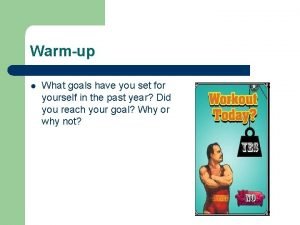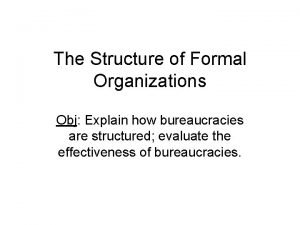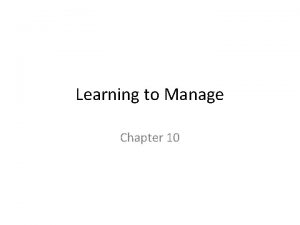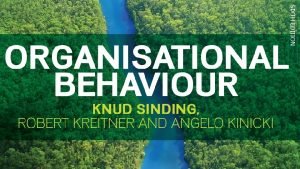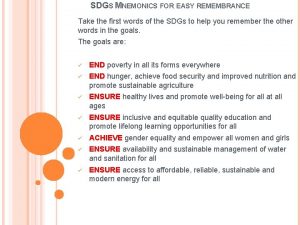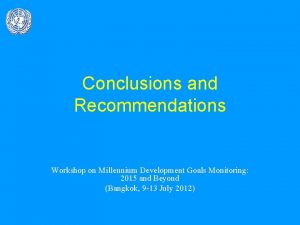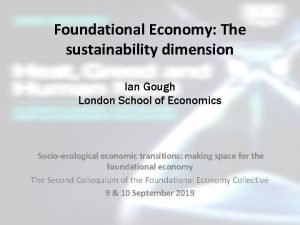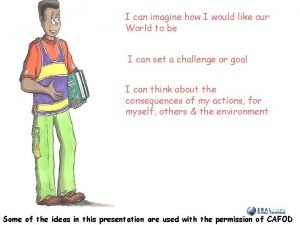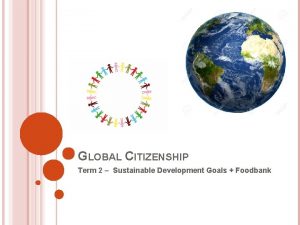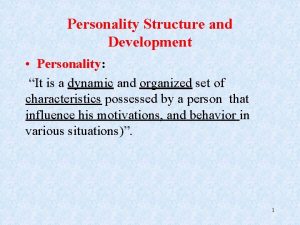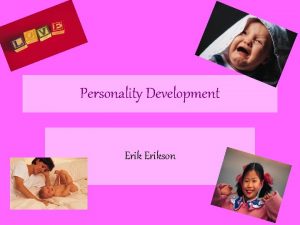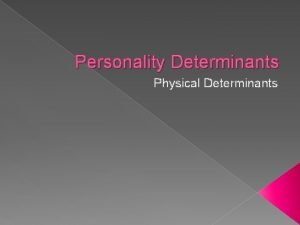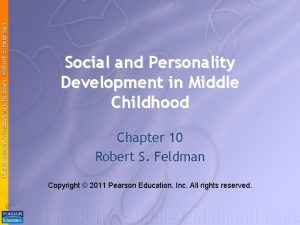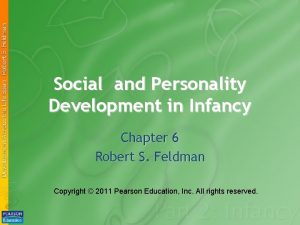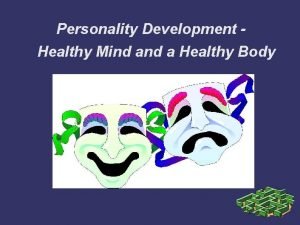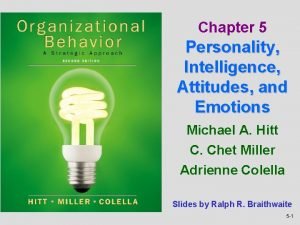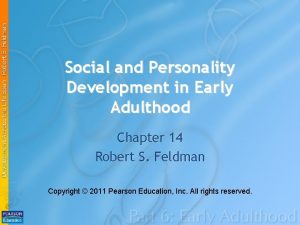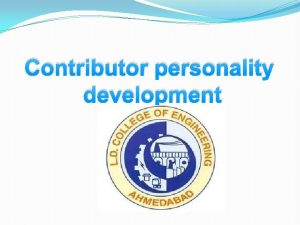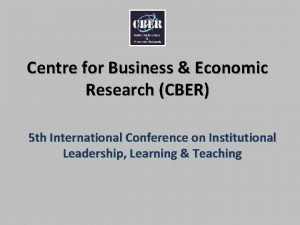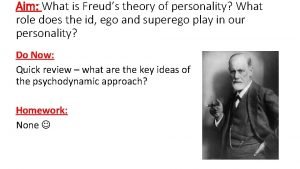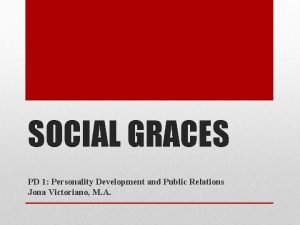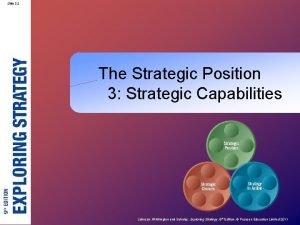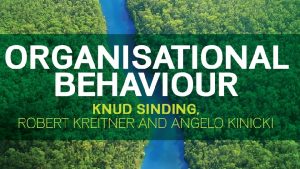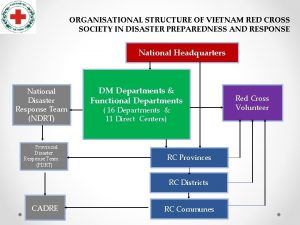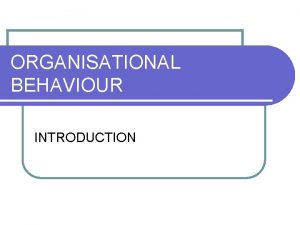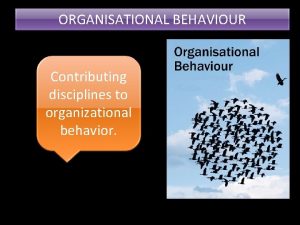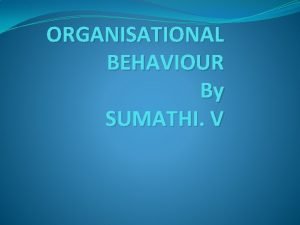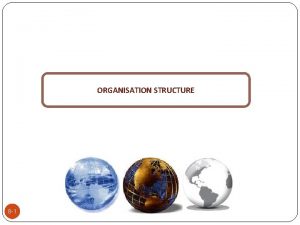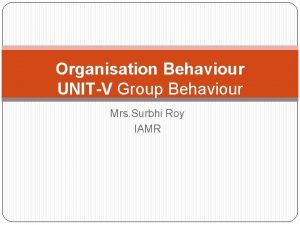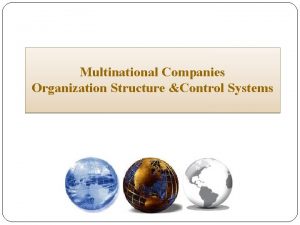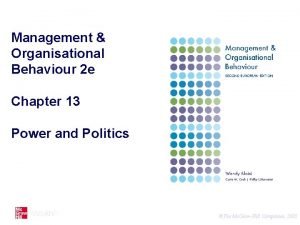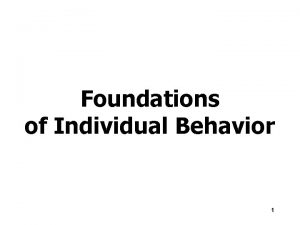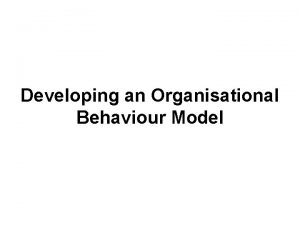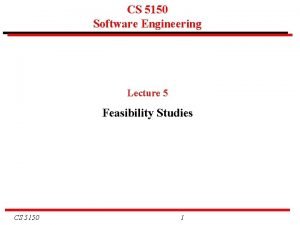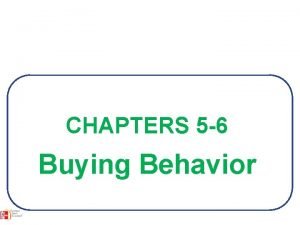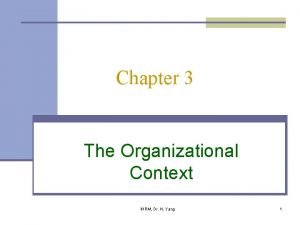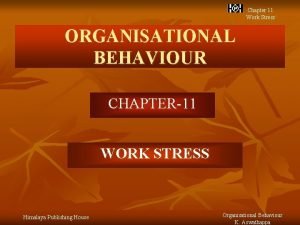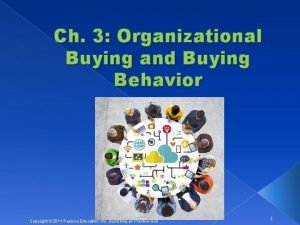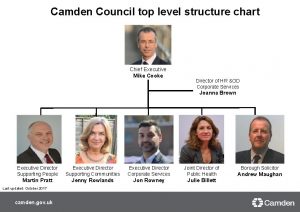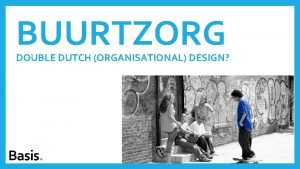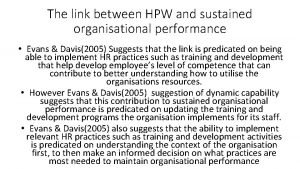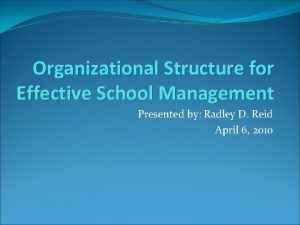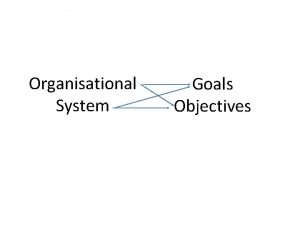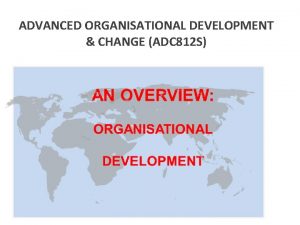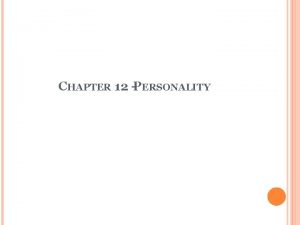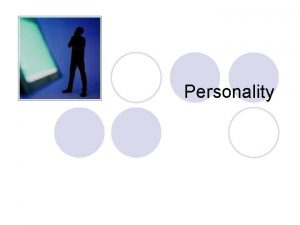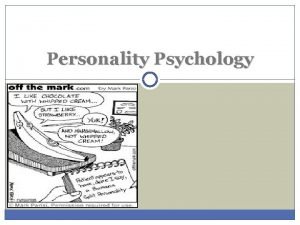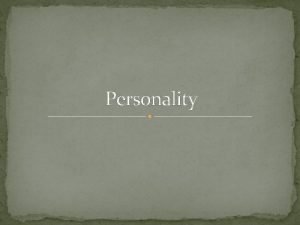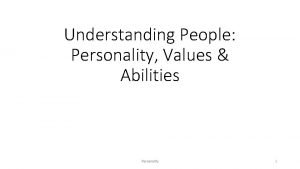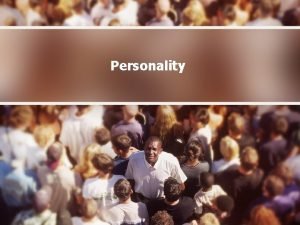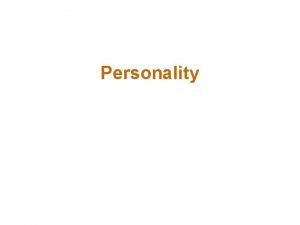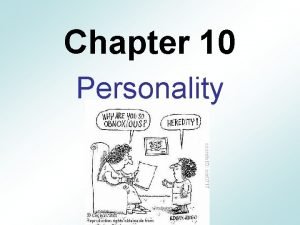PERSONALITY DEVELOPMENT TO ACHIEVE ORGANISATIONAL GOALS Dr R





























































- Slides: 61

PERSONALITY DEVELOPMENT TO ACHIEVE ORGANISATIONAL GOALS Dr. R. P. Acharya, Director, Department of Atomic Energy, India

Once upon a time a tortoise and a hare had an argument about who was faster. They decided to settle the argument with a race. They agreed on a route and started off the race.

The hare shot ahead and ran briskly for some time. Then seeing that he was far ahead of the tortoise, he thought he’d sit under a tree for some time and relax before continuing the race.

He sat under the tree and soon fell asleep. The tortoise plodding on overtook him and soon finished the race, emerging as the undisputed champ.

The hare woke up and realized that he’d lost the race. The moral of the story is that “Slow and steady wins the race”

This is the version of the story that we have all grown up with.

But then recently, someone told me a more interesting version of this story. It continues….

Root Cause The hare was disappointed at losing the race and he did some Defect Prevention (Root Cause Analysis). He realised that he’d lost the race only because he had been overconfident, careless & lax.

If he had not taken things for granted, there’s no way the tortoise could have beaten him. So he challenged the tortoise to another race. The tortoise agreed.

This time, the hare went all out & ran without stopping from start to finish. He won by several miles.

The moral of the story Ø Fast & consistent will always beat the slow and steady.

If you have two people in your organisation, one slow, methodical & reliable, and the other fast and still reliable at what he does, the fast and reliable chap will consistently climb the organisational ladder faster than the slow, methodical chap

It’s good to be slow and steady; but its better to be fast and reliable.

But the story doesn’t end here. The tortoise did some thinking this time, and realized that there’s no way he can beat the hare in a race the way it was currently formatted. He thought for a while, and then challenged the hare to another race, but on a slightly different route.

The hare agreed. They started off. In keeping with his self-made commitment to be consistently fast, the hare took off and ran top speed until he came to a broad river

The finishing line was a couple of kilometers on the other side of the river. The hare sat there wondering what to do. In the meantime the tortoise reached, got into the river, swam to the opposite bank, continued walking & finished the race.

The moral of the story ? First identify your core competency & then change the playing field to suit your core competency.

The Story still hasn’t ended !

The hare and the tortoise, by this time, had become pretty good friends & they did some thinking together. Both realized that the last race could have been run much better. So they decided to do the last race again but to run as a team this time.

They started off, and this time the hare carried the tortoise till the riverbank.

Then, the tortoise took over and swam across with the hare on his back.

On the opposite bank, the hare again carried the tortoise and they reached the finishing line together. They both felt a greater sense of satisfaction than they’d felt earlier.

The moral of the story It’s good to be individually brilliant & to have strong core competencies; but unless you’re adoptable & grab other’s core competencies, you’ll always perform below par because there will always be situations at which you’ll do poorly & someone else does well.

GOOD PERSONALITY Attributes of a person with “Good personality”? Good physique Pleasing manners Personal and Professional integrity Trustworthiness and reliability Good control over body and mind

HEALTHY BODY


CIRCUMSTANCES CHANGE RAPID

THE MORPHOLOGY OF ORGANIZATION

ORGANISATIONAL CULTURE Every Organisation is having its culture which is : Prevailing since long Might be inherited from similar organisation and improved upon subsequently Adopted under tough situation and are continued

CULTURE MEANS: The Customs, Ideas and Social Behaviour of a particular people or group - Oxford English Dictionary

Customs Ideas Practices Collectively evolve into Tradition : A long established custom or belief passed on from one generation to another

Every Organisation has: Ø Different Generations a) Depending upon the nature, size and existence of the organisation b) Experienced professionals c) New Entrants

Organisational Diversity ? Is obvious and due to: • Different behavioral Dimensions of the stake holders • Expectations of the stake holders • Policy of the organisation • Policy of the regulators • Mid field Playing or Scoring a goal by the employees • Lively zoo or Rich Museum

Diverse Activities Scale ofof operation - Individual or small group activity - Cooperative work in a large group - Large multidisciplinary tasks Nature of work Level ofof classification - Curiosity based research - Data collection & assimilation - Development of equipment, technique, process - Mission oriented activities - O&M of facilities - Service Open domain … … Completely classified domain

Common Factor for Motivation Finding an identity in an Ocean To be a Key Player in achieving institutional goals To be able to serve others

Contradictions Individual Creativity Collective Achievement Obedience Arrogance One-up manship Midfield playing Humility (respect for others work) Scoring a goal

DESIRABLE LINKAGES Programmes Facilities Human Resources Every one is a cog in the machine and need to be developed

KEY FACTORS OF PERSONALITY DEVELOPMENT A person is identified by his/her personality – public image. It is the totality of the person and not merely external looks, but character, behavioral traits and attitude towards life. Personality development – is the integral improvement of Personality, behavioral traits such as communication skills, interpersonal relationships, attitude towards life and restoring our ethics.

Know your personality Character traits Integrity Acceptan ce Discipline Behavioral traits Attitudinal Change Interpersonal Skills Positive Attitude Communication Skills Win-win situation Leadership Qualities Keep the end in mind Dedication Stress and Time management Synergise

HEALTHY BODY Nutrition – Restriction of junk foods Personal Hygiene Exercising Traditional methods (Yoga, Pranayam etc. ) Modern methods (Gym, aerobics, etc. ) Walking and jogging Disciplining of daily routines is a must! Mind control is essential for a healthy body.

WHEN IS MIND UNHEALTHY? Agitated mind is unhealthy What agitates human mind? Ø Ø Ø Not getting what one desires Getting what one dislikes Uncontrolled emotions in the mind Continuous accumulation of such likes and dislikes stresses the mind. Stress agitates the mind Stressed mind is unhealthy

HEALTHY MIND Stress-free mind is healthy and calm Such calm mind can be controlled more easily De-stressing the mind is needed: HOW? Prevention of accumulation of day-today complexes Clearing the stockpile of stored complexes

CULTIVATING A HEALTHY MIND Documented human experience of the past: Non-reactive observation of oneself mitigates the strength of these complexes Continuous awareness makes this a continuous process: results in clearing the stockpile Different paths for removal of accumulated complexes: Path of service Path of intellectual analysis (Dancing Peacock)

TYPES OF PERSONALITY Nine Types Achievers Adventurers Asserters Helpers Observers Peacemakers Perfectionists Questioners Romantics

CONT. . Achievers – are energetic, optimistic, self assured and goal oriented Ex: Sachin Tendulkar Adventurers – are energetic, lively and optimistic, contributors to the world Ex: Neeta Ambani Asserters – are direct, self-reliant, self confident and protective Ex: T. N. Seshan , Helpers – are warn, concerned, nurturing and sensitive to other people’s needs (Ex: Mother Teresa). Observers – have a need for knowledge and are introverted, curious, analytical and insightful. Ex: Dr. H. J. Bhava,

CONT. . Perfectionists – are realistic, conscientious and principled Ex: Narendra Modi. Peacemakers – are receptive, good-natured and supportive. They seek union with others and the world around them Ex: Atal Bihari Vajpayee, Questioners – are responsible and trustworthy. Ex: Amit Shah Romantics – have sensitive feelings and are warm and perceptive Ex: Ravi Verma the great Indian painter

FIVE KEYS TO EFFECTIVE SUPERVISORY COMMUNICATION Expressive speaking Empathetic listening Persuasive leadership Sensitivity to feelings Informative management

ONE-WAY & TWO-WAY COMMUNICATIONS One-Way Communication – Here, while an individual sends a message to another no questions, feedback, or interaction follow. It is n Good for giving simple assertive directions n Fast but often less accurate than 2 -way Communication Two-Way Communication - the communicator & receiver interact n Good for problem solving

BARRIERS OF COMMUNICATION Physical barriers Perceptual barriers Emotional barriers Cultural barriers Language barriers Gender barriers Interpersonal barriers

IT CAN HELP IN THE FOLLOWING WAYS To learn the business etiquette of introduction, exchanging cards, wishing on first meeting, bowing when you are visiting /visited and like this. . . Voice modulation, communication skills, phone etiquette, hygiene, empowerment skills, time management and positive thinking. To cultivate a friendly, interactive manner demands Essentials like giving a speech, voice development and modulation of voice. It enhances the sense of confidence and self -worth.

PERSONALITY PARAMETERS Value system Emotional reaction to a critical situation Moods and characteristic behaviour traits. Maturity in handling a crisis. Ability to adjust to the stress of day-to- day executive lifestyle. Self-confidence, personal ambition, emotional control and sociability etc.

BODY LANGUAGE Body language communicates much more than words. Body- language-signals are called ‘leakages’ because you may try to tell something, but the truth will leak out visually.

AVOID SUCH BODY LANGUAGE Ø Ø Ø Ø Ø Biting nails Crossed arms or legs Carrying books or papers across your chest Drumming fingers Rocking legs Slumped posture Sitting perched on the edge of the chair Tapping foot Wringing hands

CONT. . Covering your mouth with your hand while talking q Clearing your throat too much q Fiddling with the jewelry or hair q Hands in the pocket q Playing with watch or cufflinks q Rocking in your chair q Scratching a lot q Straightening your tie q

LOOKING AGGRESSIVE q Arms folded across the chest q Staring q Pointing q Making a fist q Leaning over someone q Behaving Rudely- e. g Working when someone is talking to you, Whispering, Cracking knuckles, Standing too close, Packing up folders and papers well before the meeting is over, Shaking hands too hard, Yawning, looking watch, blinkering, nail biting …. .

LEADERSHIP QUALITIES Co-operation Definiteness of plans Doing more than being paid for Mastery of details Pleasing personality Sympathy and understanding Sense of justice and fairness Courage Self-control Willingness to assume full responsibility

PERSONAL QUALITIES accurate adaptable can work under -pressure careful committed competent cooperative Courteous independent worker Lively with others extrovert decisive dedicated energetic methodical meticulous orderly organized positive practical thorough thoughtful vigilant work well Be Sensitive flexible friendly get on well with other people good communicator good sense of humour good time-keeper hard working Imaginative logical loyal self confident self motivated

TYPE A AND TYPE B Type A Personality • Always moving, walking, and eating rapidly. • Feel impatient with the rate at which most events take place. • Strive to think or do two or more things at once. • Cannot cope with leisure time. • Are obsessed with numbers, measuring their success in terms of how many or how much of everything they acquire. Type B Personality • Never suffer from a sense of time, urgency, with its accompanying impatience. • Feel no need to display or discuss either their achievements or accomplishments unless such exposure is demanded by the situation. • Play for fun & relaxation, instead of exhibit their superiority at any cost. • Can relax without guilt.

BIG 5 IN SHORT… Personality Factors 1. 2. 3. 4. 5. Conscientiousness Agreeableness Neuroticism Openness Extroversion Characters Careful, dependable and self disciplined 2. Courteous, good natured, empathic and caring. 3. Secure and calm. 4. Sensitive, flexible, creative and curious. 5. Outgoing and cautious. 1.

DO NOT FORGET: q. No matter how beautiful/ handsome, smart you are; Gorillas also attract tourists q. No matter how big and strong you are, you shall not carry yourself to the grave yard q. No matter how tall you are, you can never see tomorrow

THANKS
 Strategic goals tactical goals operational goals
Strategic goals tactical goals operational goals Strategic goals tactical goals operational goals
Strategic goals tactical goals operational goals A multistep strategy to achieve your goals
A multistep strategy to achieve your goals Large secondary group formed to achieve specific goals.
Large secondary group formed to achieve specific goals. Wisely using resources to achieve goals is known as
Wisely using resources to achieve goals is known as Types of personality in organisational behaviour
Types of personality in organisational behaviour General goals and specific goals
General goals and specific goals Examples of generic goals and product-specific goals
Examples of generic goals and product-specific goals Footloose industry definition ap human geography
Footloose industry definition ap human geography Sdgs mnemonic
Sdgs mnemonic Millinium development goal
Millinium development goal Millennium development goals conclusion
Millennium development goals conclusion Un sustainable development goals
Un sustainable development goals Un 2015 sustainable development goals
Un 2015 sustainable development goals Poster sustainable development goals
Poster sustainable development goals Suistainable development goals
Suistainable development goals Sustainable development goals 2
Sustainable development goals 2 Splitting defense mechanism example
Splitting defense mechanism example Mistrust vs trust
Mistrust vs trust Physical defects in personality development
Physical defects in personality development Personality development in infants
Personality development in infants Damon's stages of friendship
Damon's stages of friendship Personality development in infancy
Personality development in infancy Summary of personality development
Summary of personality development Determinants of personality development
Determinants of personality development Personality development in early adulthood
Personality development in early adulthood Contributor and non contributor
Contributor and non contributor Conclusion personality
Conclusion personality Freud's theory of personality
Freud's theory of personality Social graces
Social graces Contributor identity
Contributor identity Transactional analysis in organisational behaviour
Transactional analysis in organisational behaviour Ouh organisational structure
Ouh organisational structure Alton towers business
Alton towers business Organisational capabilities
Organisational capabilities What is group dynamics in organisational behaviour
What is group dynamics in organisational behaviour Organisational structure of rrb
Organisational structure of rrb Organizational structure of red cross
Organizational structure of red cross Organisational culture tutor2u
Organisational culture tutor2u Behavioristic framework of ob
Behavioristic framework of ob Contributing disciplines to organisational behaviour
Contributing disciplines to organisational behaviour Equity theory of motivation
Equity theory of motivation In the s-o-b-c model o represent
In the s-o-b-c model o represent Samsung company structure
Samsung company structure What is group dynamics in organisational behaviour
What is group dynamics in organisational behaviour Domestic structure plus foreign subsidiary
Domestic structure plus foreign subsidiary Power in organisational behaviour
Power in organisational behaviour Kotak mahindra bank organisational structure
Kotak mahindra bank organisational structure Biographical characteristics in organisational behaviour
Biographical characteristics in organisational behaviour Ethekwini municipality management structure
Ethekwini municipality management structure What is autocratic model of organizational behavior
What is autocratic model of organizational behavior Feasibility report software engineering
Feasibility report software engineering Organisational buying process
Organisational buying process Organisational stress
Organisational stress Organisational context of ihrm
Organisational context of ihrm Stress in organisational behaviour
Stress in organisational behaviour Organizational buying process
Organizational buying process Martin pratt camden
Martin pratt camden Buurtzorg organization structure
Buurtzorg organization structure Types of organisational strategies
Types of organisational strategies Link between hpw and competitive advantage
Link between hpw and competitive advantage School organizational structure
School organizational structure


